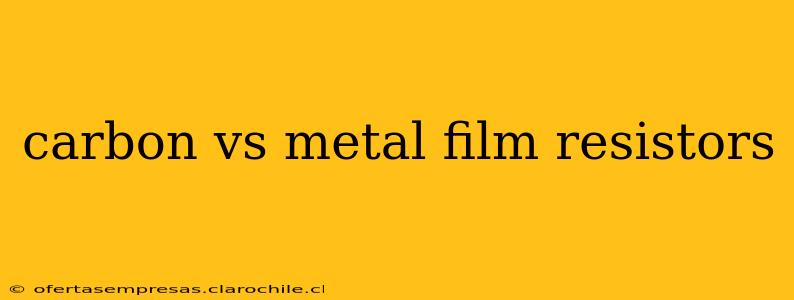Choosing the right resistor for your electronic project can seem daunting, especially with the variety available. Two common types are carbon film and metal film resistors. While both serve the same basic function—resisting the flow of current—they differ significantly in performance characteristics. This comprehensive guide will dissect the key differences between carbon film and metal film resistors, helping you make informed decisions for your projects.
What are Carbon Film Resistors?
Carbon film resistors are a cost-effective and widely used type of resistor. They're made by depositing a resistive carbon film onto a ceramic core. This film is then encased in an insulating coating. Their affordability makes them popular in many applications where precision isn't paramount.
Advantages of Carbon Film Resistors:
- Low cost: This is their primary advantage, making them ideal for high-volume applications and hobbyist projects where budget is a major concern.
- Wide availability: Easily found at most electronics suppliers.
- Compact size: Suitable for applications where space is limited.
Disadvantages of Carbon Film Resistors:
- Higher tolerance: Typically have a tolerance of ±5% or ±10%, meaning their actual resistance may deviate significantly from the marked value. This lack of precision can be problematic in sensitive circuits.
- Lower stability: More susceptible to changes in resistance due to temperature variations and aging.
- Higher noise level: Can generate more electrical noise than metal film resistors, potentially affecting sensitive audio or signal processing applications.
- Lower power rating: Generally have lower power handling capabilities compared to metal film resistors.
What are Metal Film Resistors?
Metal film resistors are constructed by depositing a thin film of metal alloy onto a ceramic core. This process allows for much tighter tolerances and better stability compared to carbon film resistors.
Advantages of Metal Film Resistors:
- Higher precision: Offer tighter tolerances, typically ±1% or even ±0.1%, ensuring greater accuracy in circuits.
- Better stability: Less susceptible to temperature changes and aging, leading to more consistent performance over time.
- Lower noise: Generate significantly less noise than carbon film resistors, making them suitable for sensitive applications.
- Higher power rating: Often available with higher power handling capabilities.
Disadvantages of Metal Film Resistors:
- Higher cost: More expensive than carbon film resistors.
- Higher inductance: Can exhibit slightly higher inductance than carbon film resistors, which might be a factor in high-frequency applications.
Carbon Film vs. Metal Film Resistors: Key Differences Summarized
| Feature | Carbon Film Resistor | Metal Film Resistor |
|---|---|---|
| Cost | Low | High |
| Tolerance | ±5%, ±10% (typically) | ±1%, ±0.1% (typically) |
| Stability | Lower | Higher |
| Noise | Higher | Lower |
| Power Rating | Lower | Higher |
| Temperature Coefficient | Higher | Lower |
Which Type Should You Choose?
The best choice depends entirely on your specific application.
-
Choose carbon film resistors if:
- Cost is a major constraint.
- High precision isn't critical.
- The application is relatively low-power and not sensitive to noise.
-
Choose metal film resistors if:
- Precision and stability are paramount.
- You need low-noise performance.
- The application demands high power handling.
What is the difference in their temperature coefficient?
The temperature coefficient refers to how much the resistance changes with temperature fluctuations. Metal film resistors generally exhibit a much lower temperature coefficient than carbon film resistors. This means their resistance remains more stable over a wider range of temperatures. This is a crucial consideration in applications where temperature variations are significant.
What are the typical applications for each type of resistor?
Carbon film resistors are commonly found in applications where cost is a priority, such as general-purpose electronics, hobbyist projects, and high-volume manufacturing. Their lower precision is acceptable in many non-critical circuits.
Metal film resistors are preferred in applications demanding high accuracy and stability, such as precision instrumentation, audio equipment, and telecommunications. Their low noise and superior temperature stability are crucial in these sensitive circuits.
Are there any other types of resistors I should know about?
Yes, besides carbon film and metal film resistors, other types include wire-wound resistors (for high power applications), thick-film resistors (often used in surface-mount technology), and thin-film resistors (offering very high precision). The best choice always depends on the specific needs of your project.
This detailed comparison provides a solid foundation for understanding the differences between carbon and metal film resistors, allowing you to select the optimal component for your electronic design. Remember to always consult datasheets for specific resistor values and performance characteristics.
